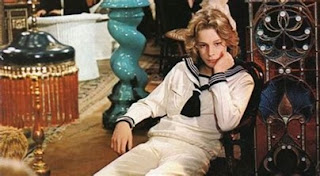appreciation and confusion
by Douglas Messerli
Luchino Visconti and Nicola Badalucco
(screenplay, based on Thomas Mann’s Death
in Venice), Luchino Visconti (director) Morte a Venezia (Death in
Venice) / 1971
The first time I saw Luchino Visconti’s Death in Venice, in its 1971 premiere, I was not particularly impressed. The film seemed static, and too dependent upon the Gustav Mahler connection through its music, who himself in 1870 announced that he was gay, despite his marriage to Alma, who went on, after his death to marry Walter Gropius and Franz Werfel. I found the movie by Visconti languid and too fawning about the young Polish young beauty Tadzio (Björn Andrésen).
I
might, in those days, even agreed with Roger Ebert’s assessment:
Visconti…misses, or avoids, the subtlety of
the novel's development of the relationship between the two characters. In the
Mann version, the man can never really know what the boy thinks of him; they do
not speak, and if the boy favors him sometimes with a look or a smile, he
favors many others as well, because that is his nature. It is entirely
possible, the way Mann tells the story, that the boy is totally unaware of any
homosexual implication -- and the man, indeed, may also be in love with an
ideal rather than a person. No such possibility exists in the heavy-handed
Visconti retelling. The boy's function in the film, which he performs at least
two dozen times, is to self-consciously pose in front of the man, turn slowly,
smile sweetly, and turn languorously away. This is almost literally the only
physical characteristic the boy has in the movie; and Visconti lays on the
turns, looks, and smiles with such a heavy hand that the boy could almost be
accused of hustling.
Tadzio’s constant turns to the elderly Aschenbach are both an admittance
of the observation of his body, but also represent an utter confusion. Why is
the old man looking so intentionally at me
Neither of these tragic figures—we might well presume the young Tadzio
dies in the epidemic just as Aschenbach dies of heart disease—can comprehend
one another.
I
once had a professor at the University of Wisconsin, Thomas Vogler, who taught
Mann’s Death in Venice, who dared to
declare in his classroom that the real problem of this work was that Aschenbach
never declared his love to Tadzio.
The day I chose to watch Visconti’s classic film, my computer was
inexplicably not functioning, and I was forced to view it on out TV, on which
films, no matter how loud we register them, sound always muted. It was,
however, not a bad choice. For Death in
Venice, in the end, is a kind of silent movie. Except for the Maler score,
hardly anyone speaks, and when they do it is with quiet gestures and almost
mute statements. This is a film (and even in Mann’s version) a work of
quietude. No one really says what’s truly on their minds. The water laps up to
their feet, their hips, and, if you listen attentively, the Venice ocean waters
slurp into the city. You can hear them quite clearly, but the character’s
voices are always at a hush. Polite, refined, unable to express themselves, the
figures are entrapped in the sinking city, unable to express their obvious
desires. In the oceanic influx, Tadzio’s and Aschenbach’s bodies become utterly
intertwined.
Los Angeles, May 20, 2019
Reprinted from World Cinema Review (May 2019).





No comments:
Post a Comment